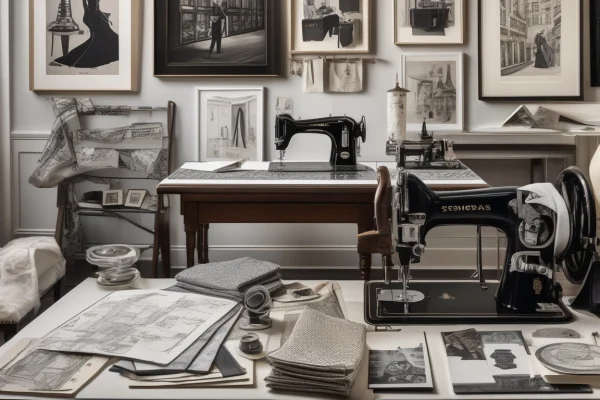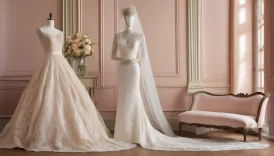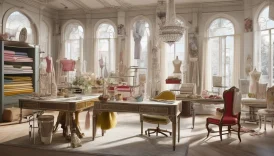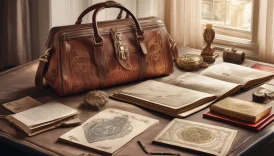Who Inspired Coco Chanel’s Fashion Empire?

Coco Chanel, a name synonymous with elegance and innovation, didn’t just wake up one day to create a fashion empire. Her journey was shaped by a myriad of influential figures and pivotal moments that ignited her passion for fashion. Born in 1883, Chanel’s early life was marked by hardship, but it was these struggles that fueled her desire to redefine women’s clothing. Can you imagine a world where women were still confined to corsets and restrictive garments? Chanel saw this and said, “No more!”
- Who Inspired Coco Chanel’s Fashion Empire?
- The Early Influences on Chanel
- Fashion Icons of the Time
- The Role of Gabrielle Bonheur Chanel
- Chanel's Revolutionary Designs
- Chanel and the Art World
- The Influence of Feminism
- Chanel’s Lasting Legacy
- Modern Designers Inspired by Chanel
- The Enduring Appeal of Chanel's Style
- Frequently Asked Questions
Her inspirations were as diverse as they were profound. From the liberating spirit of the Roaring Twenties to the bold strokes of contemporary artists, every facet of her life contributed to her groundbreaking designs. It’s fascinating to think about how a simple piece of fabric could transform into a symbol of freedom and empowerment. Chanel’s unique vision was not just about fashion; it was about creating a lifestyle that celebrated the modern woman.
In the vibrant tapestry of her life, we find key figures who played a significant role in shaping her aesthetic. Artists like Pablo Picasso and writers like Jean Cocteau were not just contemporaries; they were her muses. Their avant-garde ideas and revolutionary thoughts seeped into her creations, pushing the boundaries of what was considered fashionable. This blend of art and fashion was revolutionary, creating a ripple effect that still resonates today.
As we delve deeper into Chanel’s world, we uncover the feminist undertones that influenced her work. The suffragette movement and the changing roles of women inspired her to craft clothing that was both stylish and functional. She believed that fashion should empower women, allowing them to express their individuality without sacrificing comfort. Isn’t it incredible how one woman’s vision can inspire countless others to break free from societal norms?
In essence, Coco Chanel’s fashion empire was built on a foundation of inspiration drawn from her life experiences, the art world, and the evolving role of women in society. Her legacy is a testament to the power of creativity, resilience, and the relentless pursuit of freedom in fashion.

The Early Influences on Chanel
Coco Chanel’s journey into the world of fashion was not just a stroke of luck; it was deeply rooted in her early life experiences and the influences that shaped her. Born on August 19, 1883, in Saumur, France, Chanel faced a challenging childhood. After her mother passed away when she was just 12 years old, she was sent to an orphanage, where she learned to sew. This skill would later become the cornerstone of her fashion empire.
Chanel’s time in the orphanage was pivotal. Surrounded by nuns, she was introduced to the discipline of craftsmanship and the importance of simplicity in design. These early lessons were crucial in developing her unique aesthetic. She once said, “Simplicity is the keynote of all true elegance,” a mantra that would guide her throughout her career.
Moreover, the cultural landscape of France during her formative years played a significant role in her inspirations. The Belle Époque era, characterized by opulence and artistic innovation, surrounded Chanel with art and fashion that would ignite her passion. She was particularly influenced by the works of famous artists and designers of the time, who were breaking boundaries and redefining beauty.
Chanel’s early experiences were not just limited to hardship; they also included moments of inspiration. The women in her life, especially her aunt, who introduced her to the world of fashion, fueled her desire to create. It was these strong female figures that shaped her vision of empowering women through clothing. Chanel’s designs were not just about aesthetics; they were about liberation. She aimed to free women from the constraints of corsetry and restrictive garments, allowing them to embrace a more comfortable and modern wardrobe.
In summary, Chanel’s early influences were a blend of hardship, creativity, and powerful female role models. These elements coalesced to form the foundation of her revolutionary approach to fashion, setting the stage for her future innovations and the legacy she would leave behind.

Fashion Icons of the Time
As Coco Chanel navigated the vibrant world of fashion in the early 20th century, she was not alone in her journey. The era was teeming with fashion icons who not only inspired her but also shaped the very fabric of style itself. From the elegant silhouettes of the Victorian era to the bold statements of the roaring twenties, these figures left an indelible mark on Chanel’s designs.
One cannot discuss the fashion landscape of Chanel’s time without mentioning the likes of Paul Poiret. Known for liberating women from the constraints of corsets, Poiret’s designs emphasized fluidity and freedom, echoing the very principles that Chanel would later adopt. His extravagant creations and theatrical fashion shows introduced a new way of thinking about clothing, paving the way for Chanel’s minimalist yet bold approach.
Additionally, the influence of Elsa Schiaparelli cannot be overlooked. Schiaparelli was a master of blending art and fashion, often collaborating with surrealist artists like Salvador Dalí. Her avant-garde designs challenged traditional norms and opened doors for Chanel to experiment with her own artistic vision. The playful yet sophisticated aesthetic that Schiaparelli championed resonated deeply with Chanel, encouraging her to push the boundaries of women’s fashion.
Moreover, the impact of Marilyn Monroe and her iconic style in the 1950s cannot be dismissed. Although she rose to fame after Chanel’s initial successes, Monroe’s embodiment of femininity and glamour aligned perfectly with Chanel’s vision. The way Monroe donned Chanel No. 5, declaring it her favorite perfume, created a lasting association between the actress and the brand, further cementing Chanel’s status in the fashion world.
In essence, the fashion icons of the time provided a rich tapestry of inspiration for Chanel. They encouraged her to embrace innovation while respecting the artistry of fashion. As she absorbed lessons from these trailblazers, Chanel began to carve out her own unique path, ultimately changing the course of fashion history forever.
The Role of Gabrielle Bonheur Chanel
Gabrielle Bonheur Chanel, affectionately known as Coco, was not just a fashion designer; she was a revolutionary force in the world of style. Born in 1883 in Saumur, France, her early life was marked by hardship and resilience, which would later reflect in her groundbreaking designs. Coco’s childhood experiences, including her time in an orphanage after her mother’s passing, instilled in her a strong desire for independence and self-expression. These formative years ignited a passion for fashion that would challenge the norms of her time.
What set Coco apart was her ability to blend personal identity with her creative vision. She famously said, “Fashion is not something that exists in dresses only.” This philosophy was rooted in her belief that fashion should embody the spirit of the woman wearing it. Coco understood the complexities of femininity and sought to create clothing that allowed women to feel liberated and confident. Her designs were a direct response to the constraints of the corseted styles of the early 20th century, emphasizing comfort and practicality without sacrificing elegance.
Coco Chanel’s journey was also marked by her relationships with influential figures in the arts and society. She mingled with artists, writers, and musicians, drawing inspiration from their creativity. For instance, her relationship with the famous artist Pablo Picasso and her friendship with the composer Igor Stravinsky helped shape her artistic vision. Chanel’s ability to weave the artistic movements of her time into her designs set her apart from her contemporaries. She didn’t just follow trends; she created them, often pulling from the world around her.
In essence, Gabrielle Bonheur Chanel was a trailblazer who transformed women’s fashion. Her unique perspective and fierce determination to redefine femininity laid the groundwork for modern fashion as we know it today. She taught women that style is not just about aesthetics, but about expressing one’s true self through clothing. Coco Chanel’s legacy is a testament to the power of individuality and the impact of a visionary who dared to challenge the status quo.
Chanel’s Revolutionary Designs
Coco Chanel was not just a designer; she was a trailblazer. Her revolutionary designs transformed the fashion landscape and redefined women’s clothing. Gone were the days of corsets and constrictive garments. Chanel introduced a sense of freedom and comfort that resonated with women seeking to express their individuality. One of her most iconic contributions was the little black dress, which she famously declared as a staple for every woman’s wardrobe. This simple yet elegant piece was a game-changer, allowing women to feel chic and sophisticated without the fuss of elaborate clothing.
Chanel’s designs were deeply influenced by her own life experiences. Growing up in a convent, she learned the value of simplicity and practicality. This background shaped her philosophy that fashion should be accessible and functional. She often used luxurious fabrics in unexpected ways, like jersey, which was traditionally used for men’s underwear, to create elegant yet comfortable attire for women. Chanel’s ability to blend masculine and feminine elements in her designs set her apart from her contemporaries, allowing women to embrace a new sense of identity.
Another revolutionary aspect of Chanel’s designs was her approach to accessories. She believed that accessories could elevate any outfit, and she popularized the use of costume jewelry. This allowed women to adorn themselves without the burden of expensive pieces, making elegance more attainable. Chanel’s signature pearls and gold chains became synonymous with her brand, showcasing how accessories could complement and enhance the overall look.
In summary, Chanel’s revolutionary designs were not just about clothing; they were about empowering women. Her innovative spirit and commitment to comfort and style changed the way women dressed, paving the way for future generations of designers. Chanel’s legacy is a testament to the idea that fashion is not just what we wear, but a reflection of who we are.
Chanel and the Art World
Coco Chanel’s journey through the fashion landscape was deeply intertwined with the art world. She didn’t just create clothing; she crafted a lifestyle that echoed the avant-garde movements of her time. Chanel was known for her friendships with various artists, including the likes of Pablo Picasso and Jean Cocteau, who not only inspired her but also shaped her aesthetic vision. Imagine walking through the streets of Paris in the early 20th century, where the air was thick with creativity and rebellion—this was the backdrop of Chanel’s formative years.
Her collaborations with artists brought a unique flair to her designs. For instance, the bold colors and geometric shapes often found in her collections can be traced back to her interactions with the Cubist movement. Chanel embraced the idea of breaking away from traditional forms, much like the artists she admired. This synergy between fashion and art allowed her to create pieces that were not just garments, but wearable art.
Moreover, Chanel’s love for the arts extended beyond her personal connections. She often drew inspiration from the theatrical world, incorporating elements of performance into her fashion shows. The dramatic flair and storytelling aspects of her presentations captivated audiences and set a new standard for fashion exhibitions. It was as if each show was a mini production, where models became the leading characters in a narrative crafted by Chanel herself.
In summary, the art world significantly influenced Chanel’s designs and philosophy. Her ability to blend fashion with artistic expression not only revolutionized how clothing was perceived but also paved the way for future designers to explore this dynamic relationship. Today, we continue to see echoes of her innovative spirit in the works of contemporary designers who recognize the importance of art in fashion.
The Influence of Feminism
The feminist movements of the early 20th century were not just a backdrop for Coco Chanel; they were a driving force that shaped her vision of women’s fashion. As women began to assert their independence, Chanel recognized the need for clothing that reflected this newfound freedom. Gone were the days of corsets and restrictive garments; instead, women craved comfort and style that allowed them to move through life with confidence. Chanel’s designs were revolutionary, embodying the spirit of feminism by offering practical yet chic alternatives to traditional women’s wear.
Chanel’s creations, such as the iconic little black dress and the relaxed silhouette of the Chanel suit, symbolized a shift towards modern femininity. These garments were not just about aesthetics; they represented a powerful statement of autonomy and self-expression. By liberating women from the constraints of fashion, Chanel became a pioneer in promoting the idea that women could be both fashionable and free.
The influence of feminism on Chanel’s work can be seen in several key aspects:
- Empowerment: Chanel’s designs empowered women to embrace their identities, enabling them to dress for themselves rather than for the male gaze.
- Comfort: By prioritizing comfort and functionality, Chanel created clothing that allowed women to engage fully in society.
- Rebellion: Her bold choices, such as using traditionally masculine fabrics and styles, challenged societal norms and expectations of femininity.
In essence, Coco Chanel did not just create fashion; she crafted a revolution that resonated with the feminist ideals of her time. Her legacy is a testament to the power of design in shaping cultural narratives and empowering women. Today, as we reflect on her influence, it’s clear that Chanel’s work was not merely about clothing; it was about liberation, identity, and the enduring fight for women’s rights.

Chanel’s Lasting Legacy
Coco Chanel’s influence on the world of fashion is nothing short of monumental. Her ability to blend elegance with practicality revolutionized women’s clothing and paved the way for future generations of designers. Chanel introduced a new way of dressing that emphasized comfort without sacrificing style, a concept that remains relevant today. Imagine walking into a room wearing a piece that not only looks stunning but also feels like a second skin—this was the essence of Chanel’s vision.
The legacy of Chanel is woven into the very fabric of modern fashion. Her iconic designs, such as the Chanel No. 5 perfume and the classic Chanel suit, continue to inspire countless fashion houses. In fact, many contemporary designers cite her as a primary source of inspiration. For instance, a survey of modern designers revealed that:
| Designer | Inspired By |
|---|---|
| Karl Lagerfeld | Chanel’s timeless elegance |
| Stella McCartney | Chanel’s innovative spirit |
| Marc Jacobs | Chanel’s bold use of color |
Moreover, Chanel’s impact extends beyond clothing; she played a significant role in the feminist movement by empowering women to embrace their independence through fashion. Her designs were not just about aesthetics; they were a statement of freedom. Women no longer had to be confined to corsets and restrictive clothing. Instead, Chanel encouraged them to express their individuality and strength.
As we look at the fashion landscape today, it’s clear that Chanel’s legacy is alive and well. The elements of her style—such as the little black dress, quilted handbags, and the use of tweed—continue to captivate fashion enthusiasts around the globe. In essence, Chanel didn’t just create fashion; she created a movement that transformed how women view themselves and their wardrobes.
Modern Designers Inspired by Chanel
Coco Chanel’s influence on the fashion world is nothing short of monumental. Her ability to blend elegance with comfort has paved the way for countless modern designers who draw inspiration from her groundbreaking work. Today, many fashion creators pay homage to Chanel’s legacy, infusing her signature styles into their collections while adding their unique twists.
One standout designer is Karl Lagerfeld, who not only led Chanel as its creative director for over three decades but also embodied the spirit of Chanel in his own collections. Lagerfeld’s designs often featured the iconic tweed suits and little black dresses that Chanel made famous, but he also introduced a contemporary flair that kept the brand relevant.
Another designer who channels Chanel’s essence is Stella McCartney. Known for her commitment to sustainability, McCartney incorporates Chanel’s timeless silhouettes into her collections while promoting eco-friendly practices. Her work exemplifies how modern designers can honor the past while embracing the future.
Additionally, Alber Elbaz of Lanvin drew heavily from Chanel’s ethos of empowering women through fashion. His designs often featured bold colors and playful patterns, reminiscent of Chanel’s innovative spirit. Elbaz believed that fashion should be accessible and fun, much like Chanel’s own philosophy.
To illustrate the diverse ways in which Chanel’s influence manifests in modern fashion, here’s a brief overview of some notable designers inspired by her work:
| Designer | Key Influence |
|---|---|
| Karl Lagerfeld | Revived classic Chanel aesthetics with a modern twist |
| Stella McCartney | Timeless silhouettes with a focus on sustainability |
| Alber Elbaz | Empowering designs that celebrate femininity |
Chanel’s spirit lives on in these designers and many others, proving that her vision was not just a moment in time but a lasting influence that continues to shape the fashion landscape. As we look to the future, it’s clear that the essence of Chanel will always remain a guiding force in the world of style.
The Enduring Appeal of Chanel’s Style
Coco Chanel’s style is a stunning blend of timeless elegance and modern practicality. Even decades after her passing, her designs continue to resonate with fashion enthusiasts around the globe. But what exactly makes her style so enduring? Is it the simplicity of her lines or the revolutionary spirit she infused into women’s fashion?
One of the most significant aspects of Chanel’s appeal lies in her ability to liberate women from the constraints of traditional fashion. She introduced a more relaxed silhouette, which allowed women to move freely and confidently. Just think about it: before Chanel, corsets and heavy fabrics ruled the day. Chanel said, “Fashion is architecture: it is a matter of proportions.” This philosophy not only redefined women’s clothing but also empowered them to embrace a new sense of freedom.
Chanel’s signature pieces, like the little black dress and the Chanel No. 5 perfume, have become cultural icons. These items are not just clothing or fragrances; they represent a lifestyle and a mindset. The little black dress, for instance, is the epitome of versatility. It can be dressed up or down, making it a staple in any wardrobe. Similarly, Chanel No. 5 is more than a scent; it’s an experience, a statement of sophistication that continues to attract new generations.
Another reason for the lasting allure of Chanel’s style is her ability to adapt. Chanel embraced change and innovation, often drawing inspiration from the world around her. She was not just a designer; she was an artist who understood the importance of evolution in fashion. This adaptability is evident in how modern designers continue to reinterpret her work, infusing it with contemporary elements while maintaining the essence of Chanel.
In summary, the enduring appeal of Chanel’s style can be attributed to her revolutionary approach to women’s fashion, the iconic pieces she created, and her willingness to evolve with the times. Her legacy is a testament to the idea that true style never goes out of fashion—it simply transforms.
Frequently Asked Questions
- What were Coco Chanel’s main inspirations in fashion?Coco Chanel drew inspiration from various sources, including her childhood experiences, the art world, and the evolving role of women in society. Her designs were often influenced by her desire to liberate women from the constraints of traditional fashion.
- How did feminism influence Chanel’s designs?The feminist movements of Chanel’s time played a significant role in shaping her vision. She aimed to create clothing that empowered women, allowing them to feel confident and free, which was a revolutionary concept in the early 20th century.
- Who were some of the fashion icons that influenced Chanel?During her rise to fame, Chanel was influenced by several fashion icons, including designers like Paul Poiret and artists such as Pablo Picasso. Their innovative styles and artistic expressions helped shape her unique aesthetic.
- What are some of Chanel’s most iconic designs?Some of Chanel’s most iconic designs include the Chanel No. 5 perfume, the little black dress, and the Chanel suit. These creations not only revolutionized women’s fashion but also established her as a leading figure in the industry.
- How has Chanel’s legacy impacted modern fashion?Coco Chanel’s legacy continues to resonate today, inspiring countless modern designers. Her emphasis on simplicity, elegance, and functionality in women’s fashion remains influential, and her designs are often referenced in contemporary collections.





